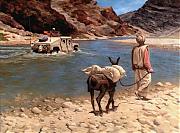... The troops have set up 19 small base camps throughout the area and begun routinely patrolling insurgent hot spots north of the Euphrates River. The deployment follows a strategy favored by a new generation of counterinsurgency experts: disperse, mingle with the population and stay put.
But the shift comes as the Pentagon appears to be moving the overall U.S. military effort in the opposite direction across much of the country. Army units are being concentrated in "super bases" that line the spine of central Iraq, away from the urban centers where counterinsurgency operations take place.
The two approaches underscore an increasingly high-profile divergence — some say contradiction — on how best to use U.S. forces in Iraq, and are evidence of a growing debate in the upper ranks about the wisest course of action.
The contrast also reflects the complicated mix of military goals and concerns as U.S. troops begin their fourth summer in Iraq. Top commanders are eager to begin shrinking the U.S. footprint, an implicit step toward a gradual withdrawal of American forces. At the same time, some field commanders are determined to break an endless cycle that allows insurgents to move back into key areas as soon as U.S. forces move on. That requires large investments of manpower...





Bookmarks